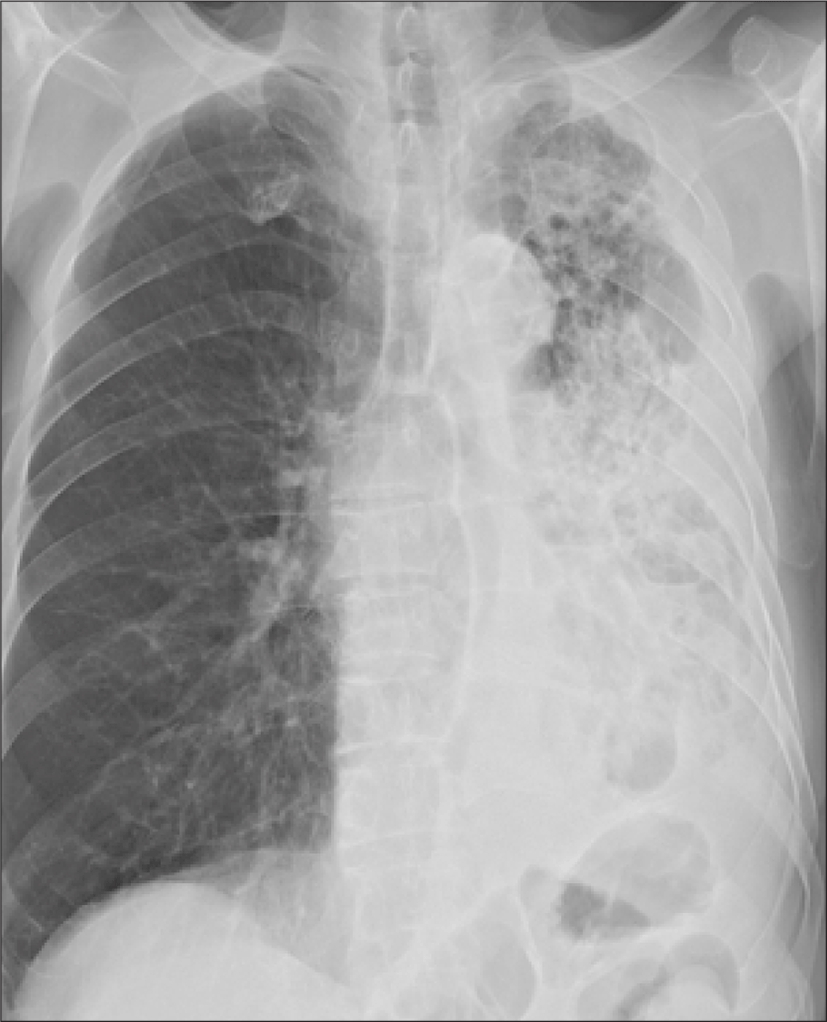Introduction
Ramsay Hunt syndrome (RHS) is defined as an acute peripheral facial nerve palsy accompanied by erythematous vesicular skin rash of the ear canal and the auricle. Compared to RHS caused by varicella-zoster virus (VZV), Bell’s palsy caused by herpes simplex virus (HSV) is known to have a lesser degree of severity of paralysis and better prognosis.1)
Herein, we present a case of a 74-year-old man who had symptoms similar to those of RHS, but tested positive for HSV. This condition has been named as Ramsay Hunt-like syndrome (RHLS) in only two articles in English literature.2,3)
Our case demonstrates that RHLS caused by HSV can lead to severe paralysis of multiple cranial nerves and vesicular lesions of the mucosa of the larynx and oropharynx. RHLS as well as RHS should be considered in patients featuring symptoms of auricular vesicular skin lesions and peripheral facial nerve palsy.
Case Report
A 74-year-old male, with medical history of hypertension and chronic obstructive pulmonary disease (COPD), visited the emergency department complaining of sore throat and left otalgia. Erythematous skin rash was observed in his left ear canal. The laryngoscopic exam showed several mucosal ulcerations of the epiglottis (Fig. 1). The patient was initially given empirical oral antibiotics under the suspicion of acute otitis externa and acute pharyngolaryngitis.
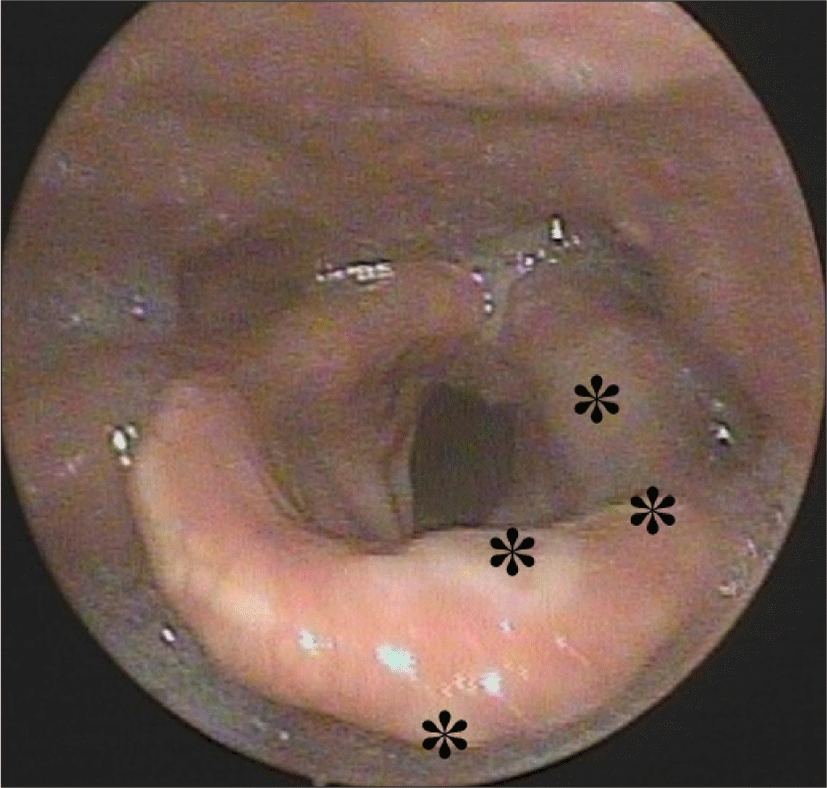
After 3 days, the patient revisited the outpatient clinic with House-Brackmann grade IV left facial nerve palsy and continuing symptom of sore throat. Multiple vesicles around his left auricle (Fig. 2A), external auditory canal (Fig. 2B) and oral cavity were observed. Mild deviation of the uvula to the right side was also present (Fig. 2C). The complete blood count revealed elevated white blood cells of 13.9×103 /µL[normal range (4.0-10.0)×103]. He was admitted to the hospital for further work up and treatment. The antiviral therapy was initiated with oral famciclovir 250 mg three times a day. Oral prednisolone (40 mg) was also given once in the morning. However, he abruptly showed a clouded consciousness, disorientation to time and place and persone concentration difficulty, which were accompanied with irritability and insomnia. Brain MRI was taken and no specific findings were found. After obtaining negative MRI scan, he was referred to our psychiatric department for further evaluation. On second day, the steroid therapy was discontinued and risperidone were administered for drug-induced delirium. The serological markers of VZV were tested under the suspicion of RHS. However, VZV IgM antibody level was negative and VZV IgG antibody level titer was 8.9 [negative <0.80 index].
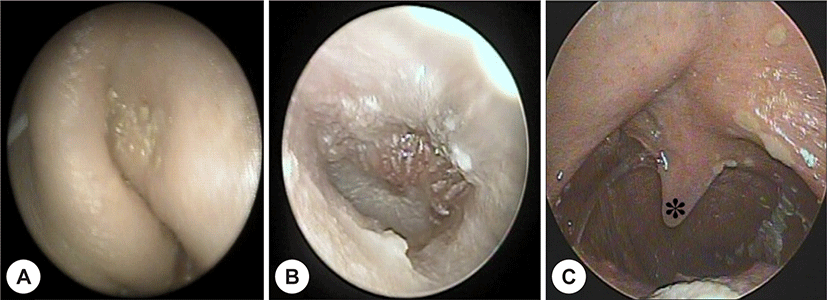
On the second day of admission, the patient kept complaining of sore throat and odynophagia. The laryngoscopic exam showed newly developed whitish patches covering the left side of the epiglottis and hypopharynx (Fig. 3). Nystatin gargle and oral fluconazole were added under the suspicion of superimposed laryngeal candidiasis at the surface of viral laryngitis
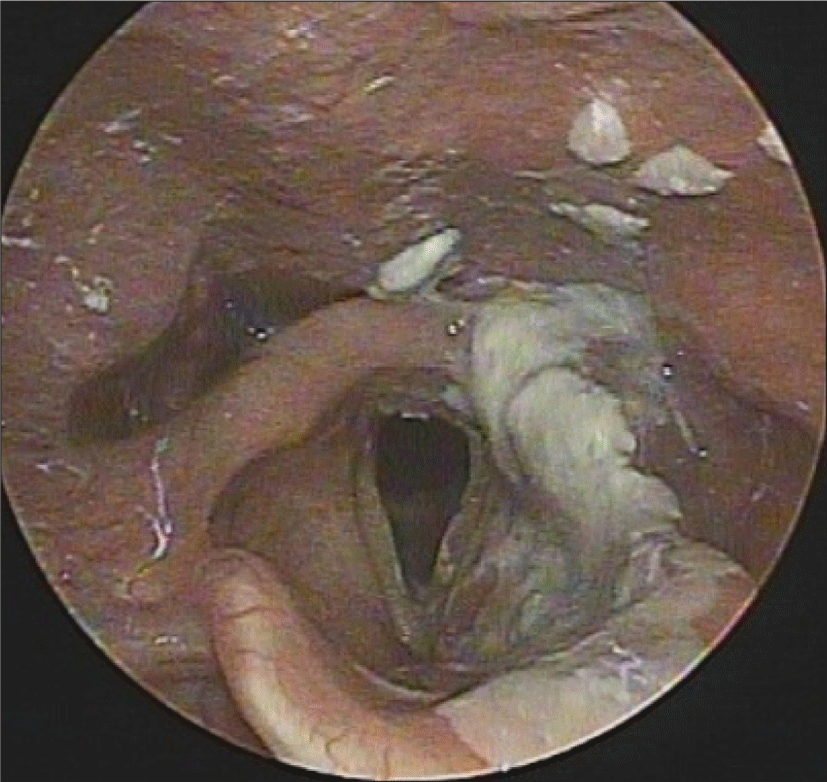
The viral markers for VZV-IgM, VZV-IgG, HSV-IgM and HSV-IgG were performed. The VZV IgM antibody was still not detected, however, HSV-IgM antibody was tested positive with a titer of 1.12 [negative <0.90 index] and HSV IgG antibody level titer was 30 [negative <0.90 index].
Over the course of 7-day antiviral therapy, vesicular rash in the external auditory canal (Fig. 4A), the whitish patches of the soft palate and the hypopharyngeal mucosa were markedly disappearing (Fig. 4B and 4C), but the symptoms of otalgia and odynophagia persisted.
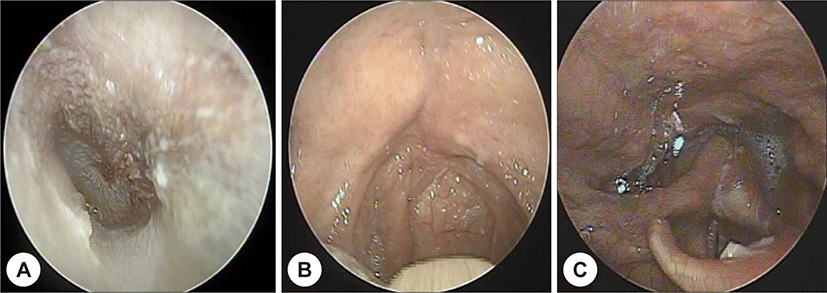
After three weeks from discharge, the patient revisited the hospital due to worsening symptoms of dyspnea and dysphagia. The laryngoscopic exam revealed left vocal cord palsy. The computed tomography scans of the neck and skull base did not show any anatomical lesions that might cause vocal cord palsy. The chest X-ray image showed left lower lobe and right upper lobe consolidation, consistent with probable aspiration pneumonia (Fig. 5). The incomplete closure of the vocal cords, known as glottic insufficiency, assumedly caused repetitive aspiration condition. He was referred to the pulmonology department for antibiotics therapy to manage pneumonia. During the admission period, we performed injection laryngoplasty for left vocal fold paralysis. We used ArteSense (European Medical Contract Manufacturing B.V., Nijmegen, The Netherlands) which consists of 20% volume of poly-methylmethacrylate microspheres suspended in 80% volume of denatured bovine collagen. Since then, his swallowing problems got much better, and the state of pneumonia also improved.
2 months after injection laryngoplasty, he achieved almost complete remission of dysphagia. Follow-up laryngoscope showed vocal fold mobility completely recovered from the previous laryngoscope (Fig. 6A and 6B). Glottic gap and vocal cord palsy were also improved, indicating recovering in glossopharyngeal nerve function. Facial paralysis also showed improvement. He could close eye and also move corners of mouth with maximal effort. All previous vesicular lesions disappeared at the left external auditory canal and tympanic membrane.
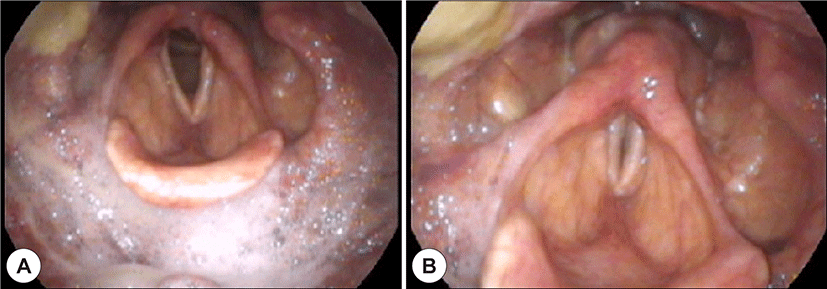
Discussion
This article reports a case of RHLS, in which the initial symptoms of sore throat, left otalgia and left auricular skin lesions were advanced to multiple cranial nerve palsies such as left facial nerve palsy, left glossopharyngeal nerve palsy and left vocal cord palsy.
Latent HSV of trigeminal, vagal, and superior cervical nerve ganglia can be reactivated in immunosuppressive conditions, and the subsequent neural damage may result in various sensory and motor nerve dysfunctions.4,5)
Our patient first had a symptom of dysphagia without vocal cord paralysis. The initial symptom of dysphagia was probably due to sore throat caused by multiple oropharyngeal ulcers and the decreased mucosal sensation of the larynx and hypopharynx.6) However, the continuing symptom of dysphagia, after the ulcerative lesions were once cured, is seemingly due to the viral invasion of the vagus nerve. This condition leads to dysphagia.7,8) HSV is known for its ability to invade multiple cranial nerves. There are some theories that explain the mechanisms by which viruses spread to multiple cranial nerves. The facial nerve is anatomically connected to the vestibulocochlear nerve, glossopharyngeal nerve and vagus nerve, which makes serial viral infection possible. In terms of blood supply, the glossopharyngeal nerve, vagus nerve and hypoglossal nerve are supplied by the ascending pharyngeal artery, while the facial nerve, maxillary nerve and trigeminal nerve are supplied by the middle meningeal artery. This blood supply system might attribute to the viral spread to multiple nerves via blood.9)
When a patient is presented with clinical symptoms of RHS, the viral markers for both VZV and HSV can be helpful in terms of diagnosis, treatment and predicting further progression of the disease.

